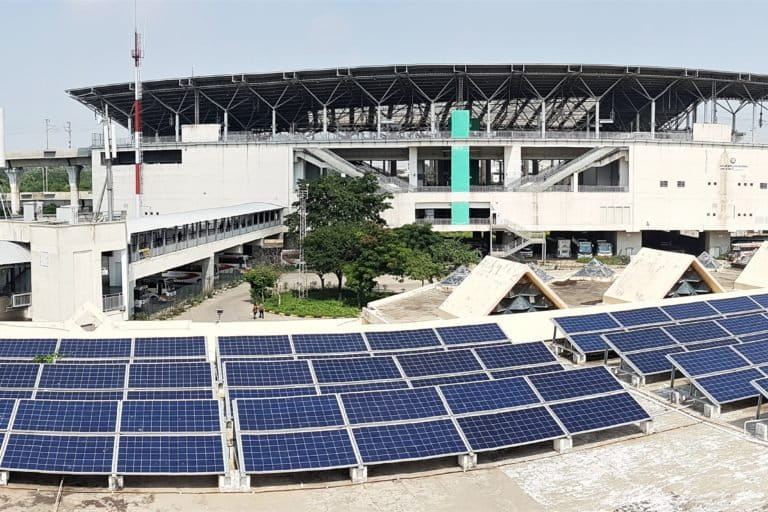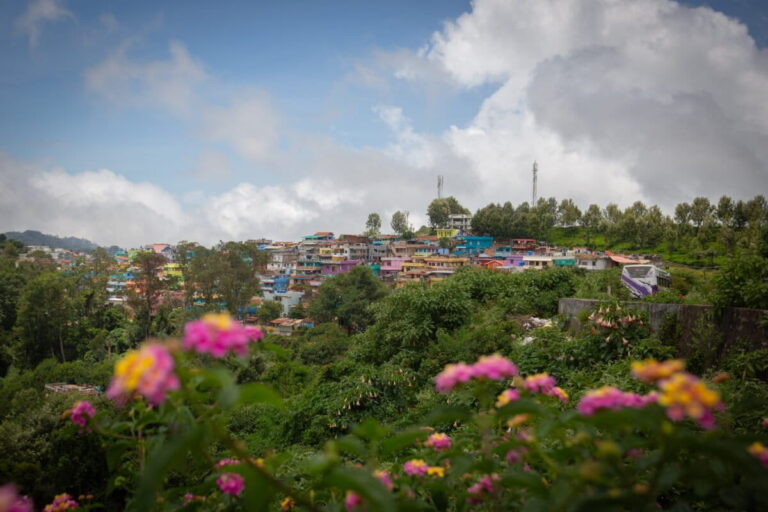- With over 280 days of sunshine, Uttarakhand has significant potential for solar power, a comparatively cleaner form of power, for its residents.
- The hill state currently continues to focus heavily on hydropower despite controversies. Considering its potential, solar power could instead be a bankable energy resource for the disaster-prone state, according to experts.
- Better planning and overcoming implementation glitches are crucial to harnessing the state’s abundant renewable power potential.
- The expansion of solar power is, however, just the beginning. Sustaining existing plants, including repair, disposal of old and worn out panels and batteries, is equally important.
The long history of natural disasters in the northern Indian state of Uttarakhand has consistently posed questions about the feasibility of new hydropower projects in the ecologically fragile Himalayan region, reeling under climate change. Activists have been seeking sustainable power solutions while stating that, with the state’s natural potential and the current policies to back it, solar power, including rooftop solar, has the potential to be a bankable power resource in the hill state.
“Solar has huge potential in Uttarakhand for power generation and heating purposes because of the abundant sunshine received and optimum ambient temperature,” said Debajit Palit, Director, Rural Energy and Livelihoods Division, TERI. Uttarakhand receives between 4-7 kWh/m2 per day of solar incident energy, nine hours daily, for around 287 sunny days a year. “But while Rajasthan, Gujarat and Uttar Pradesh have devoted vast stretches of land to utility-scale solar plants, the hill state is better suited for smaller, decentralised plants,” Palit explained to Mongabay-India. With ten of its 13 districts having hilly and rugged terrain, he emphasises that smaller solar plants on roofs of buildings will be instrumental in defining Uttarakhand’s power future.
A joint study published by researchers of Doon University and G.B. Pant University of Agriculture and Technology, in 2020, states that all Uttarakhand districts could meet over half of their electricity demand, 57 percent, using rooftop solar.
Rooftop solar is an upcoming sector in Uttarakhand. It brings down electricity bills as solar power exceeding household demand is passed on to the main grid. That amount is then deducted from the amount a resident uses in a month. The substantial cut in power tariff has been a major boost for large commercial and government establishments, as also for smaller residential setups.
Additionally, homes installing photovoltaic panels currently receive a 40 percent subsidy for plants up to 3 kW. For the next 7 kW, the assistance covers 20 percent of the project cost. However, the overall rooftop solar generation in the state is well below its estimated potential.
At the national level, the central government’s target is to install 40 GW grid-connected rooftop solar power in the country by 2022. But by October 2021, only 6.012 GW was achieved. Of this, Uttarakhand contributed nearly 4.4 percent, having a total installed capacity of 0.262 GW. The hill state aims to reach 0.350 GW by the end of 2022.
According to the Central Electricity Authority, by October 2021, Uttarakhand’s total installed power generation capacity was 3.924 GW. Hydropower generated the main share of 1.975 GW, followed by thermal power from fossil fuels at 1.011 GW. All renewable resources together produced 0.906 GW, with solar in the lead at 0.552 GW including rooftop solar, off-grid and ground-mounted plants.
Read more: Delays and glitches mar Uttarakhand’s solar self-employment scheme
Roadblocks to Uttarakhand’s rooftop solar programme
Despite having potential, what stops Uttarakhand from generating more power from the sun? Experts and those working on the ground note that a major hindrance to the rooftop solar programme is the lengthy installation and commissioning process. A mix of online application and paperwork for receiving no-objection certificates from Uttarakhand Power Corporation Limited (UPCL) is laborious and there are procedural delays. Aside from that, solar vendors install the equipment step by step as they work on several projects simultaneously.
“Customers are often held up for over a year,” shared Suraj Gaurav Sharma, who works with solar services provider S&N Merchandiser. The delay is coupled with confusion as customers depend on vendors for information who themselves are figuring things out.
The difficulties with rooftop solar continue after installation as well. For instance, after nearly a year-long process, Ashish Kunwar, a resident of Uttarakhand’s capital city Dehradun, finally set up 5-kW on-grid photovoltaic (PV) panels at his new house. For a system that had cost nearly Rs. 250,000, he paid over Rs. 160,000, saving Rs. 78,240 through subsidy. Despite solar power being generated at his residence since last October, it took eight months for regular net billing to start. “The contractual staff that came home to take readings initially seemed clueless about the new metering system,” Kunwar told Mongabay-India.
Net billing needs major reform, confirmed Anil Bakshi of Bakshi Engineering Works, a solar system integrator. “In many bills, it was found that power units exported to and imported from the grid were not adjusted accurately. Consumers have even received inflated bills.” Since tariff reduction is the prime motivation for consumers to go solar, such issues defeat their purpose.
“When consumers don’t receive regular bills, an average estimate is charged. If they hold this amount, a non-payment surcharge is levied,” explained Bakshi. In trying to fix things by filing appeals with the authorities, customers get further exhausted. “To bypass such complications, many are now turning to off-grid plants,” he noted.
A working paper published by the Asian Development Bank Institute in April 2021 identifies “poor and piecemeal implementation of net metering policies” as a major obstacle to rooftop solar. It concludes that Punjab, Uttarakhand and West Bengal have the weakest policy structure.
Recommending a solution, solar services provider Sharma said streamlined and customer-friendly operations will make rooftop solar attractive. “The UPCL needs more well-trained staff on its payroll to handle latest solar technology, calculate net bills, and redress customer complaints swiftly,” he said.

Bakshi said that the UPCL must encourage consumers by reimbursing them for surplus power generation or adjusting those units in the next billing cycle. With the current plan in Uttarakhand, the billing cycle starts afresh each time. He also advises technical upgrades at the UPCL to avoid billing delays.
Consumers have sought handouts to guide them through all aspects of installation and meter reading. Emphasising public awareness for programme success, a 2020 study published by the Indian Institute of Technology, Delhi found that insufficient information with vendors and customers created trust issues between them, and eventually led to a lukewarm response to rooftop solar in Delhi, despite the state’s promising statistics.
Read more: Is India’s rooftop solar sector being ignored for large-scale projects?
Comprehensive planning required
For a targeted expansion of rooftop solar, Uttarakhand must invest in strategic planning, stresses Abhishek Nath, energy and power expert at the Center for Study of Science, Technology and Policy (CSTEP).
“The government can carry out aerial surveys to calculate the state’s real rooftop potential, which can then be divided into various consumer segments. The segments can be selectively targeted for large-scale implementation for grid-connected and off-grid systems,” he said. “That will invite more project developers and help cut costs.”
Ashwani Chaudhary of Urza Enterprises, that designs and manufactures renewable energy products, suggests Uttarakhand should go the Punjab and Haryana way and make rooftop solar compulsory in new houseplans. He urges the state to revamp its religious tourism sector, which receives heavy annual footfall, for energy efficiency. “It is sad to see hotels at sites such as Badrinath still using polluting diesel pumps and age-old electrical appliances to heat water for pilgrims every day. They can easily be replaced with the latest solar heating systems, which are way more efficient and drastically cut power consumption and tariff with one-time investment,” he said.
Economist and environmentalist Bharat Jhunjhunwala seeks innovative solutions for the faster energy transition. “Rooftop solar is good but it can generate limited quantity,” he said while recommending that, due to space crunch, Uttarakhand could try a pilot project whereby it wheels in power from utility-scale plants it sets up in other solar-rich states. The reduced cost of solar power production in recent years will make the exercise feasible, he said.
The expansion of solar power is, however, just the beginning. Sustaining existing plants – including repair, disposal of old and worn out panels and batteries – is equally important.
“It also creates new jobs locally and protects the environment,” says Palit. A renewable workforce analysis by the Council on Energy Environment and Water (CEEW) identifies rooftop solar as the most labour-intensive sector, generating 24.72 job-years per megawatt, compared to 3.45 for ground-mounted solar, and 1.27 for wind power.
Professor Arun Kumar, a renewable energy researcher at the Indian Institute of Technology, Roorkee, said solar must be harvested fully, and it is also crucial to follow the rule book while planning and pursuing ongoing hydropower projects to avoid any complications for the environment and the people involved. He also called for strengthening the solar-hydro partnership.
Read more: Jharkhand’s solar pump scheme aims to improve lives of farmers by increasing irrigation potential
This story was produced under a fellowship supported by TERI and Internews’ Earth Journalism Network.
Banner image: Grid-connected rooftop solar plant at Ramakrishna Mission Ashram in Dehradun, Uttarakhand. Photo by Muskaan Kapoor.













